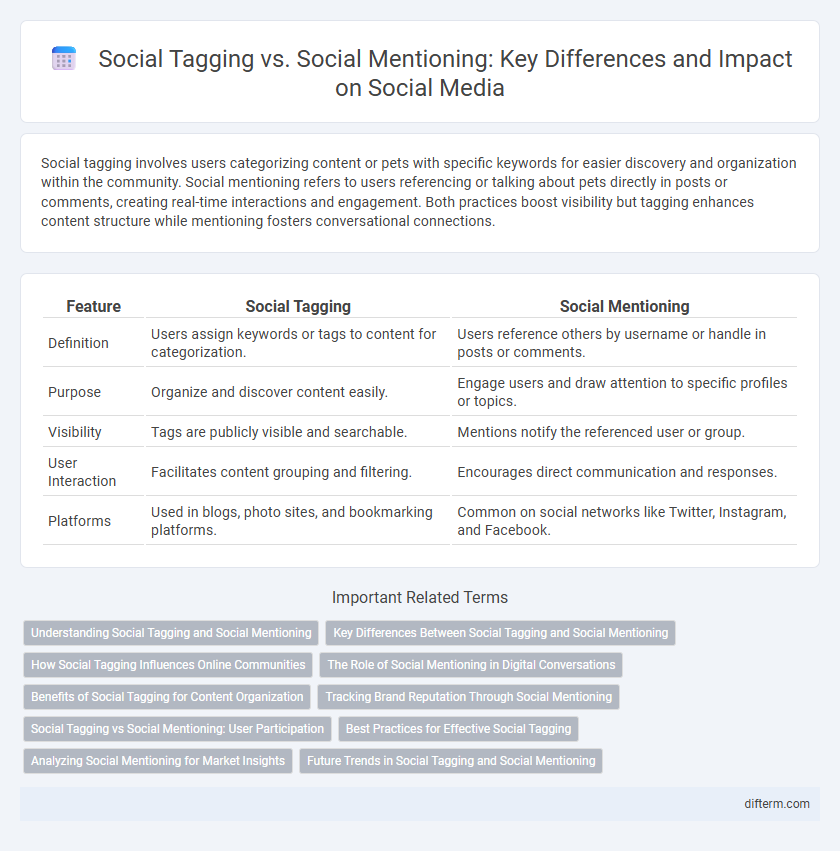Social tagging involves users categorizing content or pets with specific keywords for easier discovery and organization within the community. Social mentioning refers to users referencing or talking about pets directly in posts or comments, creating real-time interactions and engagement. Both practices boost visibility but tagging enhances content structure while mentioning fosters conversational connections.
Table of Comparison
| Feature | Social Tagging | Social Mentioning |
|---|---|---|
| Definition | Users assign keywords or tags to content for categorization. | Users reference others by username or handle in posts or comments. |
| Purpose | Organize and discover content easily. | Engage users and draw attention to specific profiles or topics. |
| Visibility | Tags are publicly visible and searchable. | Mentions notify the referenced user or group. |
| User Interaction | Facilitates content grouping and filtering. | Encourages direct communication and responses. |
| Platforms | Used in blogs, photo sites, and bookmarking platforms. | Common on social networks like Twitter, Instagram, and Facebook. |
Understanding Social Tagging and Social Mentioning
Social tagging involves users assigning keywords or labels to content, enhancing organization and discoverability across platforms. Social mentioning refers to users referencing brands, topics, or individuals within posts or comments, driving real-time engagement and sentiment analysis. Both practices are essential for monitoring online presence and tailoring content strategies in digital marketing.
Key Differences Between Social Tagging and Social Mentioning
Social tagging involves users assigning specific keywords or labels to content, enhancing organization and discoverability within social platforms. Social mentioning refers to individuals referencing or naming people, brands, or topics directly in posts or comments, increasing visibility and engagement. The key difference lies in tagging's role in categorization and metadata creation, while mentioning drives real-time interaction and direct communication.
How Social Tagging Influences Online Communities
Social tagging enables users to categorize and organize content with personalized keywords, fostering easier navigation and discovery within online communities. This collective labeling enhances community collaboration by connecting members through shared interests and improving content visibility in social networks. As a result, social tagging strengthens community engagement and supports the development of dynamic, user-driven content ecosystems.
The Role of Social Mentioning in Digital Conversations
Social mentioning plays a pivotal role in digital conversations by enabling real-time identification and analysis of brand references, sentiments, and trending topics across social media platforms. Unlike social tagging, which organizes content through hashtags and labels for categorization, social mentioning captures organic user interactions that reveal authentic consumer perceptions and emerging trends. This dynamic insight helps businesses and marketers tailor strategies, monitor reputation, and engage proactively with their audiences in an ever-evolving digital landscape.
Benefits of Social Tagging for Content Organization
Social tagging enhances content organization by enabling users to categorize and label information with relevant keywords, improving discoverability and navigation within digital platforms. This user-generated metadata creates rich contextual connections that facilitate efficient content retrieval and personalized user experiences. By fostering collaborative classification, social tagging supports dynamic content curation and knowledge sharing in online communities.
Tracking Brand Reputation Through Social Mentioning
Tracking brand reputation through social mentioning provides real-time insights by monitoring direct references to a brand across social media platforms. Unlike social tagging, which relies on user-generated labels that may be inconsistent, social mentioning captures explicit conversations and sentiment analysis related to the brand. This allows businesses to promptly address consumer feedback, identify trending topics, and manage their online reputation effectively.
Social Tagging vs Social Mentioning: User Participation
Social tagging enables users to categorize content with personalized keywords, fostering community-driven organization and enhancing content discoverability. Social mentioning involves users referencing others or topics within posts, boosting interaction through direct engagement and real-time conversations. Both methods drive active user participation, but tagging emphasizes content classification while mentioning prioritizes social connectivity and dialogue.
Best Practices for Effective Social Tagging
Effective social tagging involves using relevant and specific keywords that accurately categorize content, enhancing discoverability and engagement across platforms. Consistently tagging brands, locations, and trending topics increases visibility and fosters community interaction. Utilize analytics to track tag performance and adjust strategies to maintain audience relevance and maximize reach.
Analyzing Social Mentioning for Market Insights
Social mentioning captures real-time consumer opinions by tracking direct references to brands, products, or topics across social media platforms, providing valuable qualitative data for market analysis. Unlike social tagging, which organizes content through user-generated labels, social mentioning offers deeper sentiment analysis and trend detection by monitoring natural language use in posts and comments. Leveraging social mention data enables businesses to identify emerging market needs, measure brand perception, and tailor marketing strategies based on authentic user feedback.
Future Trends in Social Tagging and Social Mentioning
Future trends in social tagging emphasize AI-driven automation and context-aware tagging to enhance content discoverability across platforms. Social mentioning continues evolving with real-time sentiment analysis and natural language processing, enabling more precise brand monitoring and consumer insight. Integration of these technologies fosters advanced social listening tools, driving personalized marketing strategies and community engagement.
social tagging vs social mentioning Infographic

 difterm.com
difterm.com